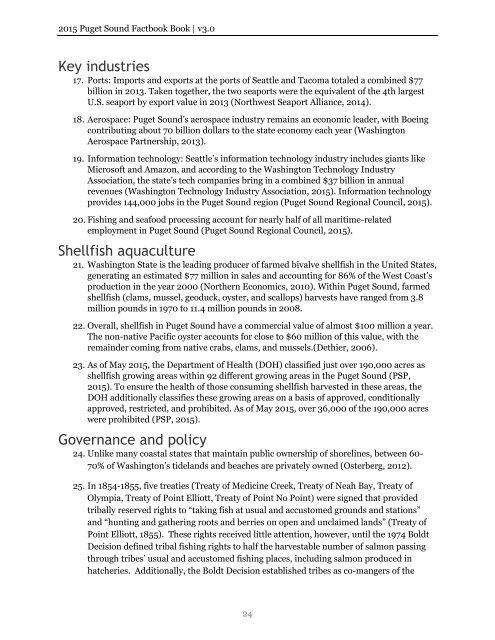You also want an ePaper? Increase the reach of your titles
YUMPU automatically turns print PDFs into web optimized ePapers that Google loves.
2015 <strong>Puget</strong> <strong>Sound</strong> Factbook Book | v3.0<br />
Key industries<br />
17. Ports: Imports and exports at <strong>the</strong> ports of Seattle and Tacoma totaled a combined $77<br />
billion in 2013. Taken toge<strong>the</strong>r, <strong>the</strong> two seaports were <strong>the</strong> equivalent of <strong>the</strong> 4th largest<br />
U.S. seaport by export value in 2013 (Northwest Seaport Alliance, 2014).<br />
18. Aerospace: <strong>Puget</strong> <strong>Sound</strong>’s aerospace industry remains an economic leader, with Boeing<br />
contributing about 70 billion dollars to <strong>the</strong> state economy each year (Washington<br />
Aerospace Partnership, 2013).<br />
19. Information technology: Seattle’s information technology industry includes giants like<br />
Microsoft and Amazon, and according to <strong>the</strong> Washington Technology Industry<br />
Association, <strong>the</strong> state’s tech companies bring in a combined $37 billion in annual<br />
revenues (Washington Technology Industry Association, 2015). Information technology<br />
provides 144,000 jobs in <strong>the</strong> <strong>Puget</strong> <strong>Sound</strong> region (<strong>Puget</strong> <strong>Sound</strong> Regional Council, 2015).<br />
20. Fishing and seafood processing account for nearly half of all maritime-related<br />
employment in <strong>Puget</strong> <strong>Sound</strong> (<strong>Puget</strong> <strong>Sound</strong> Regional Council, 2015).<br />
Shellfish aquaculture<br />
21. Washington State is <strong>the</strong> leading producer of farmed bivalve shellfish in <strong>the</strong> United States,<br />
generating an estimated $77 million in sales and accounting for 86% of <strong>the</strong> West Coast’s<br />
production in <strong>the</strong> year 2000 (Nor<strong>the</strong>rn Economics, 2010). Within <strong>Puget</strong> <strong>Sound</strong>, farmed<br />
shellfish (clams, mussel, geoduck, oyster, and scallops) harvests have ranged from 3.8<br />
million pounds in 1970 to 11.4 million pounds in 2008.<br />
22. Overall, shellfish in <strong>Puget</strong> <strong>Sound</strong> have a commercial value of almost $100 million a year.<br />
The non-native Pacific oyster accounts for close to $60 million of this value, with <strong>the</strong><br />
remainder coming from native crabs, clams, and mussels.(Dethier, 2006).<br />
23. As of May 2015, <strong>the</strong> Department of Health (DOH) classified just over 190,000 acres as<br />
shellfish growing areas within 92 different growing areas in <strong>the</strong> <strong>Puget</strong> <strong>Sound</strong> (PSP,<br />
2015). To ensure <strong>the</strong> health of those consuming shellfish harvested in <strong>the</strong>se areas, <strong>the</strong><br />
DOH additionally classifies <strong>the</strong>se growing areas on a basis of approved, conditionally<br />
approved, restricted, and prohibited. As of May 2015, over 36,000 of <strong>the</strong> 190,000 acres<br />
were prohibited (PSP, 2015).<br />
Governance and policy<br />
24. Unlike many coastal states that maintain public ownership of shorelines, between 60-<br />
70% of Washington’s tidelands and beaches are privately owned (Osterberg, 2012).<br />
25. In 1854-1855, five treaties (Treaty of Medicine Creek, Treaty of Neah Bay, Treaty of<br />
Olympia, Treaty of Point Elliott, Treaty of Point No Point) were signed that provided<br />
tribally reserved rights to “taking fish at usual and accustomed grounds and stations”<br />
and “hunting and ga<strong>the</strong>ring roots and berries on open and unclaimed lands” (Treaty of<br />
Point Elliott, 1855). These rights received little attention, however, until <strong>the</strong> 1974 Boldt<br />
Decision defined tribal fishing rights to half <strong>the</strong> harvestable number of salmon passing<br />
through tribes’ usual and accustomed fishing places, including salmon produced in<br />
hatcheries. Additionally, <strong>the</strong> Boldt Decision established tribes as co-mangers of <strong>the</strong><br />
24


